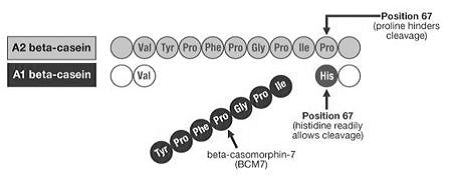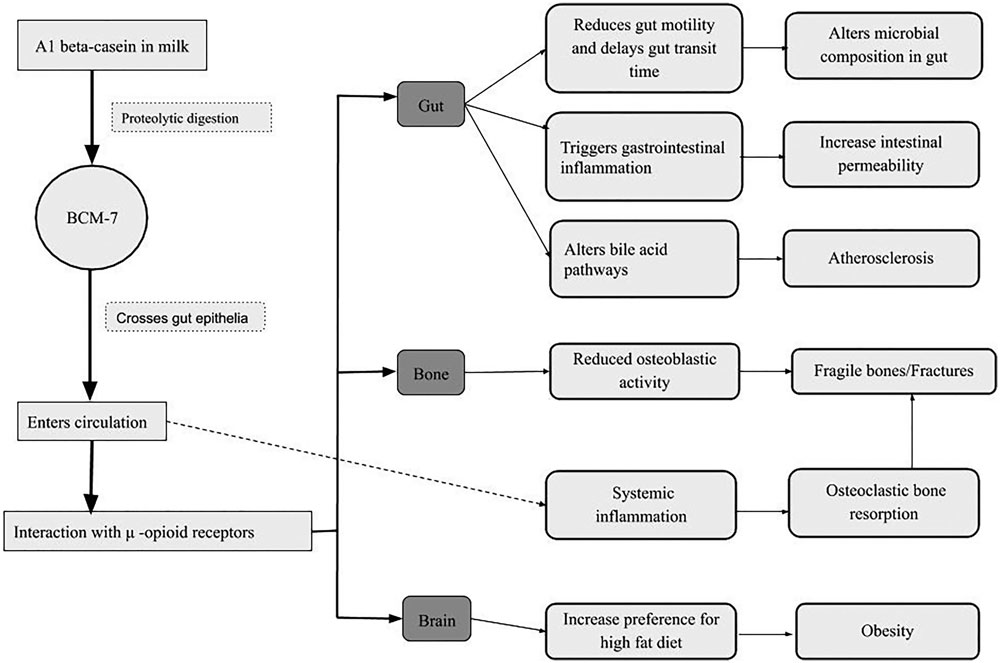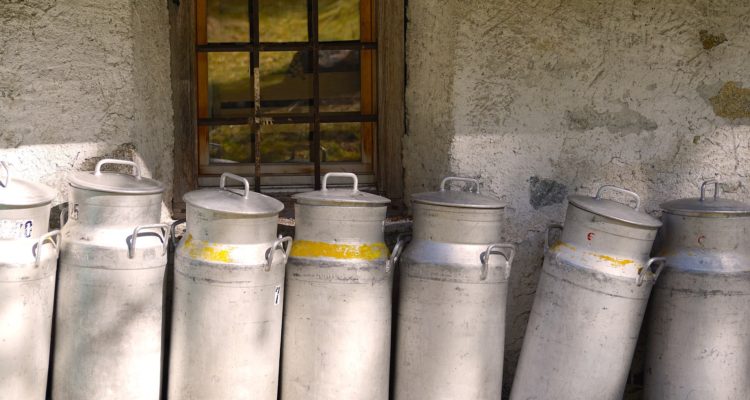A critical review from India evaluating the benefits of A2 milk over A1 milk, including Indian epidemiological and in vitro data.
◊ By Dr. Pranesh Sridharan, Ph.D & Dr. B.L. Chidananda, Ph.D
Visit ORGANIC SHOP by Pure & Eco India
In India, milk has been considered the perfect food source for ages. Milk and milk products such as clarified butter have been part of ayurvedic medications.
Milk is an important source of nutrients and micronutrients. It consists of about 87% water and 13% milk solids constituting fat, lactose, minerals and protein. Casein is the chief component of milk proteins, of which, about 30-35% is beta-casein.1
Beta-casein may be of different types based on genetic background of the animal, but the major types are A1 and A2. Beta-casein consists of a chain of 229 amino acids.
Cows producing A2 milk are known as A2 cows, while those producing A1 milk are called A1 cows. Indian Bos Indicus cows like Hallikar, Malnad Gidda, Punganur, Amrit Mahal, Gir and Sahiwal produce A2 milk, while Holstein Friesian (HF) and Ayrshire cattle breeds predominantly produce A1 milk.
The distinguishing structure between the two forms of b-casein is the presence of either histidine (His67) in A1 or proline (Pro67) in A2 at position 67 of this 209-amino acid protein, with A1 being consequential to a point mutation from Pro67 to His67 occurring in ancestors to modern European-type cattle.
Consequently, the milk produced commercially in many countries contains a mixture of A1 and A2. The His67 mutation is absent in purebred Asian and African cattle (Bos Indicus cattle – Hallikar, Malnad Gidda, Punganur, Ongole, Gir, Sahiwal, and the Red Sindhi being the prominent ones).
Similarly, the presence of a histidine mutation at the equivalent position in other mammalian species, including humans, is either absent or extremely rare. Human milk and Bos Indicus milk have similarities in Casein structure.
Within modern European-type cattle, there are additional derivative b-casein proteins through mutations at other points of the protein chain, which can be grouped within the A1 and A2 types.
The most important of these is type B b-casein, which, like A1, contains His67. Other A1 and A2 caseins can be considered minor. Most studies are not explicit as to the presence or absence of these minor variants and refer only to either ‘A1’ or ‘A2’.15

Figure 1: Release of BCM 7 from A1 beta casein during digestion.
In this review, we use the terminology of A1 and A2 as two major classifications. His67 within A1 is susceptible to proteolytic cleavage, Pro67 within A2 is not.
Thus, A1 beta-casein has the potential to release beta-casomorphin (BCM) opioid peptides, including BCM-7, during gastrointestinal digestion. The avoidance of A1 is feasible within dairy-based diets through the consumption of milk of native Indian cows.
Bovine milk, free of A1, is now available commercially in a range of countries, including Australia, the United Kingdom, the United States, New Zealand, and The Netherlands, and is widely promoted as beneficial for people who suffer from milk intolerance.
Infant formula containing casein (but free of A1) is now marketed widely in China and Australia and is promoted commercially as being more gentle on infants’ digestive systems.
GENETICS BEHIND A1 & A2 MILK
The production of A1 or A2 milk by cows is governed by the beta casein gene, which is located on chromosome number 6.
For aeons, cows have been producing A2 milk, which is regarded as safe and nutritious. The beta-casein gene was mutated and the 67th amino acid was changed from proline (A2 allele) to histidine (A1 allele).
A cow carries only two copies of the beta-casein gene. Hence, possibly, she can be of A2A2 homozygous genotype or A1A2 heterozygous genotype or A1A1 homozygous genotype.
The alleles do not have a dominant-recessive relationship, ie, both the alleles are co-dominant in nature. Thus, an A1A2 cow will produce both A1 and A2 beta casein alleles in equal proportion.
An A2A2 genotype cow will only produce A2 beta-casein and an A1A1 cow will only produce A1 beta-casein. A cow of A2A2 genotype will transmit the A2 allele to her progeny, while an A1A1 cow will pass on the A1 allele; for A1A2 cow, there is an equal chance of transmitting either allele. Breeding for A2A2 cows can be done by using semen from bulls of the A2A2 genotype.16
| Bull Genotype | Cow Genotype | Offspring Genotype |
| A2/A2 | A2/A2 | A2/A2 |
| A1/A2 | A2/A2 | A2/A2 (50%) |
| A2/A2 | A1/A2 | A2/A2 (50%) |
| A1/A1 | A1/A1 | A1/A1 |
Notably, human beta-casein and A2 beta-casein share a proline at their aligned residues, which highlights that human beta-casein is of the A2 beta-casein type and not A1 (Figure 2).

Figure 2: Human beta-casein and A2 beta-casein share a proline at their aligned residues.
EFFECT OF DIGESTIVE ENZYMES OF A1 & A2 MILK
Digestive enzymes act differently with A1 and A2 beta-casein proteins during the digestion process. Beta-casomorphin-7 (BCM-7) a bioactive 7-amino peptide, is released by digestive enzymes from the A1-beta-casein protein but these enzymes cannot split the A2 protein due to presence of proline at that location. So, BCM-7 is not released from A2 proteins’ digestion.
BCM-7 interacts with the human gastrointestinal duct, internal organs, and brainstem.1, 25, 26.
POTENTIAL HARMFUL EFFECTS OF A1 MILK
Several research papers have reported about the health hazards associated with A1 milk consumption. In Polynesia, it was observed that children consuming only A2 type milk were at lesser risk of diabetes type 1 than children who were consuming A1 milk.
An in vivo experiment in non-obese diabetic mice found a positive correlation between consumption of the β-casein A1 variant and the incidence of diabetes mellitus. BCM-7 can affect many opioid receptors in the nervous, endocrine and immune system.6
Infants are more vulnerable since they have more chance of absorption of BCM-7 because of comparatively less developed gastrointestinal tracts than adults.18
BCM-7 may act as an immunosuppressant and increase the risk of Type 1 Diabetes, Coronary Heart Disease, Arteriosclerosis, and Sudden Infant Death Syndrome (SIDS). It is also related with neurological issues like Autism or Schizophrenia.2,3, 21, 23
Beta-casein A1 is more atherogenic than beta-casein A2. A strong correlation between consumption of A1 bovine milk and incidence of ischemic heart disease (IHD) and Type 1 Diabetes Mellitus has been established.4
Analysis of food consumption data from 19 ‘healthcare-affluent’ developed countries showed strong correlations (r = 0.92) between the consumption of A1 β-casein and the incidence of type 1 diabetes.
Incidence was found to be highest in Finland and Sweden (countries with the highest A1 β-casein consumption/per capita) and lowest in Venezuela and Japan (countries with the lowest A1 β-casein consumption/per capita).22, 23
A human study to investigate the differences in antibody responses to A1 and A2 β-casein reported that the ratio of A1 to A2 β-casein antibodies was significantly higher in those with Type 1 diabetes than in controls (P<0.001).
In order to demonstrate opioid activity, BCMs should be in pharmacological concentrations that are sufficient to elicit physiological response and be able to bind to the opioid receptors.
Studies show that 4mg of BCM-7 was released in the human jejunum, 2 h after digestion of 30 g of casein, which is consistent with pharmacological effects.7, 27
BCMs need to cross the gut epithelia into circulation to have functional effects. The potential of BCMs to transfer across intestinal epithelia has been demonstrated in in-vitro experiments in animals and infants.
It is postulated that BCMs could be transferred through paracellular pathways across intestinal epithelia, ie, the intercellular space between cells – and the process may occur swiftly in infants due to the immature gut lining. 8,15, 18, 19

Figure 3: Potential pathways by which milk opioid peptides may influence physiological functions.
A2 MILK—THE INDIAN CONTEXT
Indian studies have shown that A2 milk is free from BCM-7. The populations consuming milk having more beta-casein A2 exhibit a lower occurrence of cardiovascular disease and Type 1 diabetes. People consuming A2 milk had better stool consistency, less incidence of bloating and less abdominal pain.
In India, most of the native cows produce A2 milk, which is safe for consumption.
Several research studies have attempted to study the A1 or A2 milk status in our indigenous breeds.
A study in 15 Zebu cattle breeds (Kangayam, Nimari, Red Kandhari, Malnad Gidda, Kherigarh, Malvi, Amrit Mahal, Kankrej, Gir, Sahiwal, Hariana, Tharparkar, Rathi, Mewati and Red Sindhi) and 8 River Buffalo breeds (Murrah, Mehsana, Marathwada, South Kanara, Manipur, Assamese Swamp, Nili Ravi and Pandharpuri) reported the absence of the A1A1 genotype. A2 gene was nearly at fixation (0.987) in Zebu cattle. 12
MINI-STUDY CONDUCTED BY MATHRUKA FARM
A study involving 41 cattle comprising Bos Indicus, HF and Jersey cows, was carried out at Mathruka Farm, Bengaluru, by testing blood samples of cows, with the following results.

Table 1: Prevalence of genotypes in Bos Indicus, HF and Jersey Cows.
The study offers insights on the genotype of Indian desi cows (Bos Indicus). While this is a limited study in a small sample population, it could be considered indicative of the larger population, and a basis for further larger population studies.
Hallikars, the cattle breed native to Karnataka and Tamil Nadu, has shown presence of 100% A2A2 genotypes. The other Indian cattle breeds which exhibited 100% A2A2 genotypes were Amrit Mahal, Malnad Gidda and Punganur.
In our study, the Gir breed showed a mixed result, with 80% exhibiting A2A2 genotype. The interesting aspect was detection of A1A2 genotype in Jersey cattle. Jersey had 83% of A1A1 genotype. HF exhibited 100% A1A1 genotype.
EPIDEMIOLOGICAL STUDY IN BENGALURU
This study was carried out in Bengaluru city over a period of 2 years, covering 79 subjects who shifted from A1 milk to A2 milk consumption.
The inclusion criteria was pre-existing disease condition, consumers who were consuming A1 milk and shifted to A2 milk, and consent to provide feedback on improvement based on laboratory results and medical examination by a qualified doctor.
Clinical examinations were conducted by qualified ayurvedic physicians in two clinics in Bengaluru.
Of the 79 subjects, 63 continued with the study and provided quantitative and qualitative data for 6 months. These 63 subjects were included in final analysis.
Out of 63 subjects, 11 had Type 1 Diabetes, 13 had cardiovascular problems and 39 had gastrointestinal problems associated with consumption of A1 milk.
The evaluation criteria for the subjects with cardiovascular problems was kept at base level as improvement in LDL and HDL cholesterol levels.

Table 2: Details of disease-wise enrolment of subjects and epidemiological data over 2 years.

Table 3: Statistical representation of epidemiological evaluation of impact on disease patterns, of migration from A1 milk to A2 milk.
The results from the epidemiological survey indicate that there is a potential benefit of shifting from A1 milk to A2 milk consumption. The results could indicate a potential beneficial effect of A2 milk in people at risk of developing Type 1 Diabetes and cardiovascular diseases.
The positive improvement in subjects with Type 1 diabetes was 91%, which is significant considering that most of the subjects showed a significant improvement in blood glucose levels and associated symptoms of diabetes such as neuropathy.
REFERENCES
- Advances in Nutrition 2017; 8:739–48. Systematic Review of the Gastrointestinal Effects of A1 Compared with A2 b-Casein. Simon Brooke-Taylor, Karen Dwyer, Keith Woodford and Natalya Kost.
- American Journal of Clinical Nutrition 2019 Nov 27. Comparison of the impact of bovine milk β-casein variants on digestive comfort in females self-reporting dairy intolerance: a randomized controlled trial. Milan AM, Shrestha A, Karlström HJ, Martinsson JA, Nilsson NJ, Perry JK, Day L, Barnett MPG, Cameron-Smith D.
- Annals of Neurosciences 2015 Oct; 22 (4):239-43. Milk metabolites and neurodegeneration: Is there crosstalk? Thakur K, Anand A.
- 2003 Sep; 170 (1):13-9. A casein variant in cow’s milk is atherogenic. Tailford KA, Berry CL, Thomas AC, Campbell JH.
- British Journal of Nutrition Volume 84, Issue S1 November 2000 , pp. 111-117. Immunoregulatory peptides in bovine milk. Harsharnjit S. Gill, F. Doull, K. J. Rutherfurd and M. L. Cross.
- 1999 Mar; 42(3):292-6. Type I (insulin-dependent) diabetes mellitus and cow milk: casein variant consumption. Elliott RB1, Harris DP, Hill JP, Bibby NJ, Wasmuth HE.
- European Journal of Clinical Nutrition 2005 May; 59(5):623-31. The A2 milk case: a critical review. Truswell AS.
- European Journal of Clinical Nutrition 2014 Sep; 68(9): 994-1000. Comparative effects of A1 versus A2 beta-casein on gastrointestinal measures: a blinded randomised cross-over pilot study. Ho S, Woodford K, Kukuljan S, Pal S.
- European Journal of Clinical Nutrition volume 60, pages921–924(2006). Further research for consideration in ‘the A2 milk case’. A J Allison & A J Clarke.
- 2017 Jul 12; 6(7). Production of Cow’s Milk Free from Beta-Casein A1 and Its Application in the Manufacturing of Specialized Foods for Early Infant Nutrition. Duarte-Vázquez MÁ, García-Ugalde C, Villegas-Gutiérrez LM, García-Almendárez BE, Rosado JL.
- Food Chemistry 2008 Oct 15;110(4):897-903. Release of β-casomorphins 5 and 7 during simulated gastro-intestinal digestion of bovine β-casein variants and milk-based infant formulas. Noni ID.
- Food Chemistry 2015 Feb 1; 168:70-9. Release of β-casomorphin-7/5 during simulated gastrointestinal digestion of milk β-casein variants from Indian crossbred cattle (Karan Fries). Ul Haq MR, Kapila R, Kapila S.
- Genetic and Molecular Research 2017 May 25; 16(2). Polymorphism in the Beta Casein Gene and analysis of milk characteristics in Gir and Guzerá dairy cattle. Rangel AHN, Zaros LG, Lima TC, Borba LHF, Novaes LP, Mota LFM, Silva MS.
- International Journal of Food Science and Nutrition 2012 Jun; 63(4):426-30. Milk from cows of different β-casein genotypes as a source of β-casomorphin-7. Cieślińska A, Kostyra E, Kostyra H, Oleński K, Fiedorowicz E, Kamiński S.
- International Journal of Livestock Research, 8(4), 1-7 Vol 8 (4) Apr ’18. A1 versus A2 Milk- Impact on Human Health. Behera, R., Sahu, A., Mandal, A., Rai, S., Karunakaran, M., & Dutta, T.
- J Appl Genet. 2007; 48(3):189-98. Polymorphism of bovine beta-casein and its potential effect on human health. Kamiński S, Cieslińska A, Kostyra E.
- J Dairy Sci. 2015 Jan; 98(1):15-26. In vitro digestion of purified β-casein variants A(1), A(2), B, and I: effects on antioxidant and angiotensin-converting enzyme inhibitory capacity. Petrat-Melin B, Andersen P, Rasmussen JT, Poulsen NA, Larsen LB, Young JF.
- J Pediatr Gastroenterol Nutr. 2019 Sep; 69(3):375-382. Effects of Conventional Milk Versus Milk Containing Only A2 β-Casein on Digestion in Chinese Children: A Randomized Study. Sheng X, Li Z, Ni J, Yelland G.
- Life Sciences 1983 Jun 6; 32 (23): 2611-23. Minireview. Peptides and the blood-brain barrier. Meisenberg G, Simmons WH.
- Med Hypotheses. 2001 Feb; 56 (2): 262-72. Beta-casein A1, ischaemic heart disease mortality, and other illnesses. McLachlan CN1.
- N Z Med J. 2003 Jan 24; 116 (1168):U295. Ischaemic heart disease, Type 1 diabetes, and cow milk A1 beta-casein. Laugesen M, Elliott R.
- N Z Med J. 2003 Jan 24; 116(1168):U295. Ischaemic heart disease, Type 1 diabetes, and cow milk A1 beta-casein. Laugesen M1, Elliott R.
- Nutr J. 2016 Apr 2;15:35. Effects of milk containing only A2 beta casein versus milk containing both A1 and A2 beta casein proteins on gastrointestinal physiology, symptoms of discomfort, and cognitive behavior of people with self-reported intolerance to traditional cows’ milk. Jianqin S1, Leiming X2, Lu X3, Yelland GW4,5, Ni J6, Clarke AJ7.
- Nutr Rev. 2019 May 1; 77(5):278-306. Milk A1 β-casein and health-related outcomes in humans: a systematic review. Küllenberg de Gaudry D, Lohner S, Schmucker C, Kapp P, Motschall E, Hörrlein S, Röger C, Meerpohl JJ.
- 2015 Aug 31; 7(9):7285-97. Milk Intolerance, Beta-Casein and Lactose. Pal S, Woodford K, Kukuljan S, Ho S.
- 2019 Jan 4; 11(1). Role of Milk-Derived Opioid Peptides and Proline Dipeptidyl Peptidase-4 in Autism Spectrum Disorders. Jarmołowska B, Bukało M, Fiedorowicz E, Cieślińska A, Kordulewska NK, Moszyńska M, Świątecki A, Kostyra E.
- Nutrition Journal. 2016 Apr 2; 15:35. Effects of milk containing only A2 beta casein versus milk containing both A1 and A2 beta casein proteins on gastrointestinal physiology, symptoms of discomfort, and cognitive behavior of people with self-reported intolerance to traditional cows’ milk. Jianqin S, Leiming X, Lu X, Yelland GW, Ni J, Clarke AJ.
- Nutrition Journal. 2017 Oct 25; 16(1):72. Effects of cow’s milk beta-casein variants on symptoms of milk intolerance in Chinese adults: a multicentre, randomised controlled study. He M, Sun J, Jiang ZQ, Yang YX.
- 2014 Dec; 62:144-9. β-casomorphin-7 alters μ-opioid receptor and dipeptidyl peptidase IV genes expression in children with atopic dermatitis. Fiedorowicz E, Kaczmarski M, Cieślińska A, Sienkiewicz-Szłapka E, Jarmołowska B, Chwała B, Kostyra E.
ABOUT THE AUTHORS
Dr. Pranesh Sridharan, Ph.D., is the founder of Mathruka Cattle Farm in Bengaluru and Dr. Dr. B. L. Chidananda, Ph.D, is Professor & Head, Department of Animal Sciences, College of Agriculture, Bengaluru.



Leave a Reply